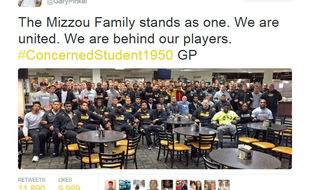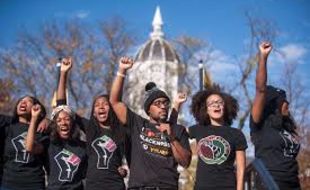On September 12, 2015, Payton Head, a student at the University of Missouri and president of the Missouri Students Association, posted on Facebook that racial slurs had been yelled at him on campus. The African American student’s post exploded on social media and across campus. Twelve days later, protests started on campus. Students denounced the university for taking several days to respond to the incident after Payton Head’s post was published.
Nearly one month later, on October 1 the students held another rally called “Racism Lives Here”, asking the University of Missouri’s administration to take action against racism on campus. Four days later, as the Legion of Black Collegians rehearsed for a school play, a drunk man shouted racial slurs at them.
On October 10, a student and protester at the university’s homecoming parade was bumped by university president Tim Wolfe’s car, as he tried to exit his parking spot blocked by students. The student protesters were subsequently removed from the street by the police.
The main student protesters’ group on campus, Concerned Student 1950, which refers to the year the first black students were admitted to the university, demanded that Wolfe be fired and that diversity training be established on campus.
On October 24, a Nazi swastika was drawn using excrement on the wall of a hall bathroom. Two days later, President Tim Wolfe met with students of Concerned Student 1950. No plan was established to answer their demands or punish those who were the source of racist slurs and acts on campus.
On November 2, 2015, Jonathan Butler, a graduate student at the University of Missouri (also known as ‘Mizzou’), began a hunger strike demanding President Wolfe’s removal from office and promising to starve to death if Wolfe remained.
Yet, even after Jonathan Butler’s hunger strike began and he became the face of the movement on campus, announcing it was the only way the administration would take action against the racist incidents that had been going on for years, the real change in the students’ protest came when the football team joined the protest. On November 8, 2015, African American players on the football team declared they would “… no longer participate in any football related activities until President Tim Wolfe resigns or is removed due to his negligence toward marginalized students' experience. WE ARE UNITED!!!!!”.
The Legion of Black Collegians tweeted a photo of the football players showing their support.
While football coach Pinkel declared all were united, the resignation of President Wolfe had high stakes. Mizzou’s revenue depends on the football team’s ticket sales and television distribution rights sales. If the football team did not play, the university would lose nearly $1 million if they did not play a scheduled football game against Brigham Young University in Kansas City, Missouri on the following Saturday.
In the 2015-2016 academic year, the University of Missouri was 77% white and 7% black. Sixty nine percent of the football players with scholarships identified as Black, while Blacks only represented 48% of the entire football team. Participating in this protest was a danger for certain younger players who risked suspension and thus not be drafted to the professional level.
Today, the athletes who protested have not had any negative consequences on their football careers. I wished to interview two seniors who participated in the protest several years ago and are currently red-shirt seniors: Ish Witter and Jason Reede. These football players used their influence as members of a team that generates much money for their university, to be involved in the school’s commitment against racism. Concerned Student 1950 dissolved throughout the Spring of 2016. According to his LinkedIn profile, Jonathan Butler has continued as a community organizer, policy advocate, and writer.
In 2015, nearly one half of Mizzou’s football team identified as African American. The players faced some tensions within the team. The athletes primarily used Twitter social media to share their opinions about the protest and raise awareness. The hashtags used included #ConcernedStudent1950 and #MizzouHungerStrike. In 2017, approximately 79% of Mizzou’s students were White and about 6% of undergraduate students were African-American, which poses another challenge in a school that is not diverse as its football team. According to a recent CNN article, more than 70% of the University of Missouri’s faculty is white, while “black representation [is] just over 3% according to the university”.
As years go by and after Tim Wolfe stepped down, I wonder how black and white on the team evolved through their practices, on campus, with and without Pinkel at the University. I wonder if they personally ever felt threatened by the racism that went on campus, or simply acted as they believed any student should on a campus where racism occurs. I am curious to know if the protest encouraged any athletes to become activists during and after college. For those who were drafted in the professional league, did they face challenges related to the protest? How has the situation evolved at the University of Missouri, from a student’s point of view and from the players’ point of view in regards to racism?



